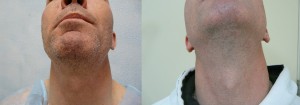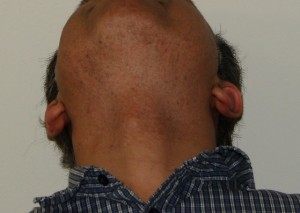This is immensely beneficial for two types of individuals in particular:
- Those suffering from advanced stages of baldness
- Individuals who need hair repair surgery but have exhausted most of their head donor follicles through previous procedure(s).
Those who are interested in undergoing BHT (body hair transplant) surgeries are encouraged to fully understand what to expect from their outcomes. Not only would this include the quality and extent of their resulting coverage, but also the appearance of the donor surfaces which often include regions such as:
- Beard regions of the face and neck
- Chest
- Shoulders
- Arms
- Back
- Legs
Wounds can be inevitably expected whenever damage is inflicted on the skin. They will occur after any type of hair transplantation procedure, including:
- Strip surgery
- Standard Follicular Unit Extraction
- Advanced FUE hair restoration through body hair transplantation
The donor surfaces of strip and regular FUE surgeries are constrained to the scalp which is usually covered by high density areas of hair. Remnants of wounds, whether linear or round are less concerning for most people since they can be camouflaged by hair.
In body hair transplant procedures, even slight markings and discolorations are far more visible and noticeable. Prospective patients should therefore become familiar with wound healing as a significant aspect of body hair transplant procedures.
Body Hair Transplant Wound Healing Manifestations
Punch tools with tiny diameters are used to extract hair follicles from the body. These will create round shaped wounds which the skin will try to heal. Patients should realize that this process will likely leave visual markings. These are typically cosmetically insignificant. And their appearance can be improved through certain interventions.
There are several types of wound healing manifestations:
- Dyschromia (skin discolorations)
- Hyperpigmentation (dark spots on the skin)
- Hypopigmentation (light spots / White dots on the skin)
- Redness
- Bumps from ingrown hairs
- Scarring
The subsequent wound healing formations will vary from person to person. This is often contingent on the individual’s skin type.
Summary of Fitzpatrick Skin Types
One way to classify the different types is skin is by using the Fitzpatrick scale. For simplicity’s sake the different levels can be understood to represent the amount of melanin in the skin and how easily the individual tans.
Type 1 – extremely pale and fair, hair color is usually red or blond, typical eye color for this category is blue, skin does not tan but will burn due to excessive sun exposure, skin is prone to freckling
Type 2 – also very fair in coloration, typical eye colors include blue, green or hazel, hair colors include blond or red, minimal tanning can be achieved but sun burns are more predominant
Type 3 – skin is pale, but more cream colored, no restrictions on hair or eye color for this category, tanning can be achieved uniformly, sunburning is usually mild and minimal
Type 4 – skin coloration is medium brown or Mediterranean olive toned, tanning is easily achieved, burning is rare
Type 5 – skin is dark brown and characteristic of individuals from the Middle East, burning is rare, tanning is easily attained
Type 6– skin is dark brown/black and never burns but tans very easily.
Certain skin type categories will usually display common wound healing patterns after a body hair transplant extraction procedure. Therefore, it is helpful for patients to know where they fall under this scale so they can better anticipate the types of wounds they can expect after their procedure.
Dyschromia
The skin may react to injuries (including punches from hair follicle extractions) by changing color. This can develop at the sites of the wound punctures.
Hyperpigmentation is a darkening of the skin. Small brown dots can develop on the donor surfaces. This happens when the skin starts to produce high levels of melanin. Melanin serves as a form of sun screen. After the skin is wounded through incisions, cuts etc., it is more vulnerable to damage from UV light. Secretions of melanin are intended to offer protection from this.
Initial hyperpigmentation is most common among Fitzpatrick types 3-6.
Hypopigmentation may occur if the skin loses its ability to produce normal amounts of melanin.It manifests as white dots or lighter toned dots in points of extraction. This is most common in darker skinned individuals (Fitzpatrick type 4-6)
Aside from skin color, the nature of the dyschromias may also vary on different parts of the body. For example, hyperpigmentation may fade faster on the arms compared to the thighs.
Larger dark or light spots may be influenced by high degrees of inflammation that may occur after graft extractions. Other variables besides genetic skin type include:
- Amount of sun exposure
- Presence of infections
Hyperpigmentation usually resolve spontaneously with time. The fading of brown spots can be facilitated with hydroquinone or even laser treatment. Hypopigmentation may improve with time as well, but it is common to have some degree of persistence. Laser resurfacing procedures may further improve this manifestation. Patients who would not accept the possibility of white dotting should not have body or beard hair transplants.
Redness
For individuals of lighter skin tones (e.g. Fitzpatrick types 1-2), spots of redness are likely to develop at the punch wounds resulting from graft extractions. This happens due to the dilation of blood vessels which results after inflammation.
Individuals with darker skin are not immune to this phenomenon. Instead, signs of inflammation are less visible due to the prominence of hyperpigmentation spots.
After several weeks to a month, most of the skin’s redness will have subsided. And further improvements can be expected after this point.
Bumps and Ingrown Hairs
Bumps due to ingrown hairs are caused by the inflammation of hair follicles. Although they usually resolve on their own (i.e about 6-8 weeks) steroids or antibiotics may be prescribed to assist with the healing process.
Body Hair Transplant (BHT) Wound Healing As Scar Tissue
Raised scar tissue is made of disorganized collagen fibers. The thick and rubbery appearance is due to the enlargement of the individual cells. This remodeling of the skin is intended to offer better protection from future punctures and abrasions (including punch extraction wounds from hair transplant procedures).
Visible scarring is more likely to occur in patients with darker skin tones. It can occur as:
- Hypertrophic scars
- Keloids
Hypertrophic scars are general forms raised scar tissue. Keloids are also raised scars which proliferate through overgrowth outside the confines of the wound.
Collagen itself forms from fibroblast cells. In those who develop keloids, there are atypical fibroblasts which produce excess amounts of collagen, fibronectin, elastin and proteoglycans. These are all components which form extracellular matrix tissue.
The tendency to form keloid scars is usually genetic in origin and mostly occurs in individuals with very dark or very light skin tones (Fitzpatrick 1 and 6)
Issues of raised scars are of particular concern for BHT patients since the donor areas are highly exposed. This is quite different from the head which is covered by large amounts of hair. However it is possible to improve or mitigate the development of such tissue.
UGraft Extractions For Body Hair Transplant Procedures
UGraft is an Advanced Follicular Unit Extraction surgical system that was developed by Dr. Sanusi Umar here at Dermhair Clinic. It is comprised of highly specialized technology as well as surgical protocols needed for successful body hair to head transplant extractions.
Body follicles have different characteristics compared to those that exist on the scalp.
- They are more fragile
- They grow at angles much smaller than ninety degrees
These issues make them prone to damage by standard Follicular Unit Extraction punch devices. UGraft includes a gentle pulling feature which is intended to gently separate the follicle from its surroundings. Generic punches rely on extreme accuracy in placing the circumference of the punch around the entire follicle. This is done to sever the surrounding connective tissue. If this excision is performed to exacting standards, forceps can then be used to retrieve the follicles by grabbing the tiny organ and sliding it out.
But mistakes can occur which end up killing the graft. With UGraft, the pulling mechanism provides a safer and improved way to remove the follicle without over relying on the placement of the circular punch incision.
A second key feature of UGraft is the an advantageous wound configuration. Compared to the typical FUE wounds, the UGraft wound edges are less divergent (less funnel shaped), rather they tend to be straighter and even converging. This favors a better external scarrng profile as this video illustrates:
With this configuration, scar tissue tends to remain under the skin surface resulting in less scar bumps for a comparable wound created by a a different punch of same diameter. After the donor area has healed, the skin’s texture typically appears smoother with less signs of raised scars.
The beard area is often relied upon to provide the needed volume for full coverage. Patients would naturally expect much higher wound healing standards, as they would not want permanent raised scars on their face and neck. With uGraft, successful extractions are achieved through large quantity donor extractions and typically insignificant cosmetic scarring which visually appears as pristine surfaces.
Here are several examples of different Fitzpatrick skin types and their BHT wound healing results. All of them had grafts extracted from their beard regions using uGraft. Raised bumps and marks are not visible as a result of creating strategic wound shapes which enables emergent scar tissue to remain under the surface.



For more information on body hair transplant wound healing for specific cases prospective patients may contact Dr. Umar by filling out the free initial consultation form at the top right of this page, or by calling the office of DermHair Clinic at 800-499-3782.


